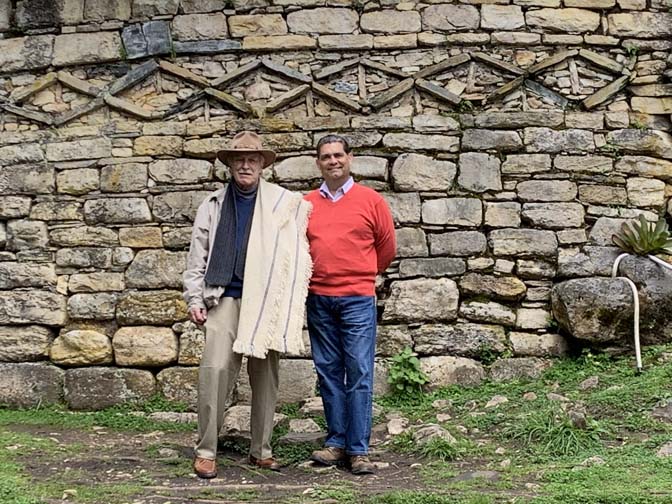
Gary Buchanan and Gene Savoy Jr at Fortaleza Kuelap, March 3, 2020
The Community is getting involved again in Peru after a lapse of several years. Following extensive legal entanglements over the nature of the Andean Explorers Foundation, The Community regained control over the unique research and valuable archives in 2019. Then COVID hit. Three years ago, the editor of the Community Communique sat down with Bishop Gene Savoy Jr. to discuss his recent visits to Peru in January and November 2018 to explore possibilities for the future work of The Community there and his vision for the future.
The interview was recorded February 11, 2019. The ending commentary was written May 24, 2022.
ED: Let’s start our discussion with an explanation of the name “Gene Savoy Xplorations.”
GSJr: In June 2018 we formed a DBA [fictitious firm name] of the Church, which is “Gene Savoy Xplorations” with an “X.” This will be the beginning of recreating our work in Peru, as the Andean Explorers Foundation as an entity is no longer part of the Church. The formation of “Gene Savoy Xplorations” as a part of The Community will also ensure that we never have the kind of problem again that we have had with incorporating the Andean Explorers Foundation, because this entity will be part of the Church and not a separate corporation subject to outside manipulation, as the Andean Explorers Foundation proved to be.
ED: And you went down to Peru a few months ago?
GSJr: I went in January of 2018 and November of 2018.
ED: And you had a plan at that time?
GSJr: Yes. The plan in January was to see what the climate was for us getting involved, and what the interest was, and, also, to see how Chachapoyas had changed. We had heard that it has changed quite significantly. And I had gotten reports that the government is spending a lot of money in Amazonas because they are very concerned with the number of people visiting Machu Picchu, and so they want to limit the number of tourists there and expand into other areas.
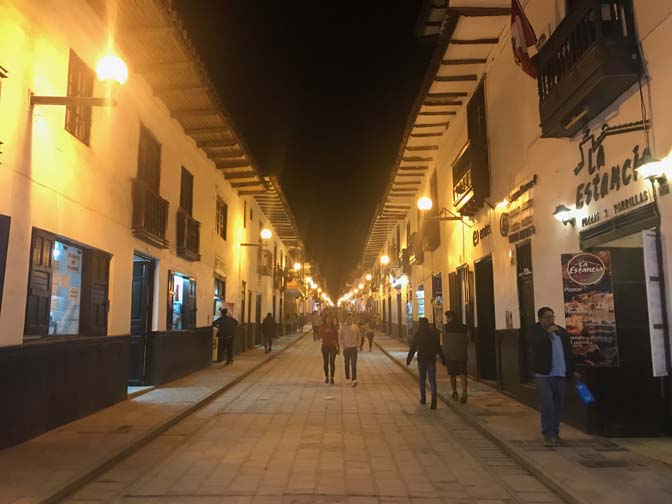
Pedestrian walkway in Chachapoyas, Amazonas, Peru
That means they have to open up additional archaeological sites, which makes sense.
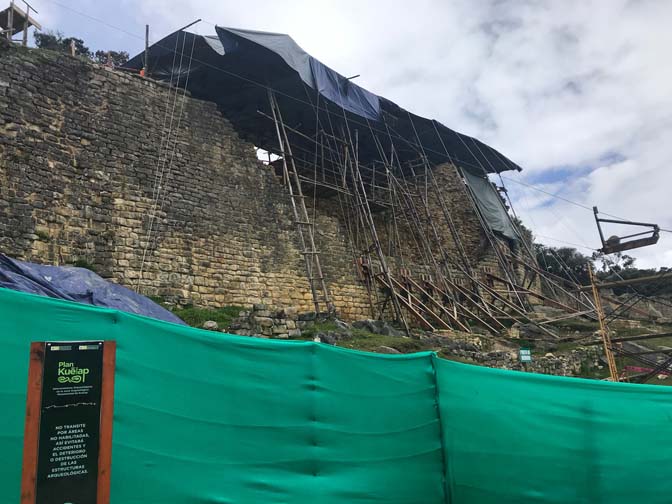
Restoration work underway at Kuelap Fortress
The next major site is Kuelap, and that’s why a magnificent cable car system going up there has been built.

New cable car tramway with old mule trail below
This is the area where we spent many, many decades working. The government is spending a great deal of money there, as I said, which interested me because we had thoughts back in the old days, in the 1990s, of how we could take advantage of the archaeological sites that my father had discovered, and how we could capitalize on that. We were letting the whole world know about these places – these archaeological sites – and where they were, but then other people were coming in and reaping the benefits of what we had discovered. And that’s fine, but we should also be a part of that. Maybe thirty years ago wasn’t the right time. But now definitely is. In the last twenty years, the Peruvian government has built national road systems that didn’t exist before. There are daily flights from Lima to Chachapoyas, which you didn’t have before. The townspeople have spent a lot of money in Chachapoyas itself, beautifying their city. It really is quite different from what it used to be when I was first there.
ED: Can you describe the way it was in the early 1990s, and the way it is now?
GSJr: Well, it was kind of like being in the old west in a way. There were horses and mules and the occasional pickup truck. People were coming in from the countryside, the campesinos [peasant farmers]. And in the best hotel in town, for example, you didn’t have private bathrooms. There was a communal bathroom. You didn’t have hot water. You showered in cold water. There was one TV in the whole town. That was a big deal. It belonged to a guy who owned a restaurant on the plaza. And everyone in town would come and watch through the doors and the windows what was on the TV because that was very novel. It’s totally different now. You have internet service. You have hotels that have private bathrooms. You have hot water. They’ve renovated a lot of the old homes with courtyards for restaurants, coffee shops and wine bars.
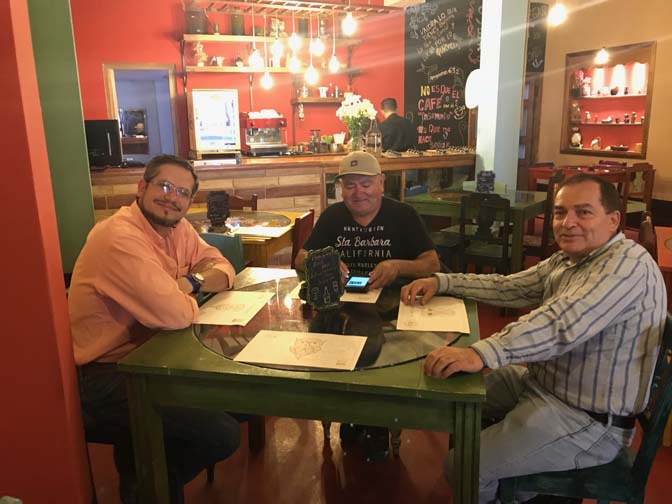
Ismael Seoane, Martin Chumbe and Eduardo Morocho at a coffee shop in Chachapyas, Amazonas, Peru
It’s just a totally different scenario. They actually have a fleet of taxis. It’s changed quite a bit. That cable car system is really phenomenal. I recommend it to anybody, if they are there. You have to take the cable car system up to Kuelap.
ED: What was it like to get from Chachapoyas to Kuelap before?
GSJr: From Chachapoyas you would take a truck to the town of Tingo, which was about an hour or an hour-and-a-half drive back in those days because they didn’t have paved roads. All of the roads are paved now.
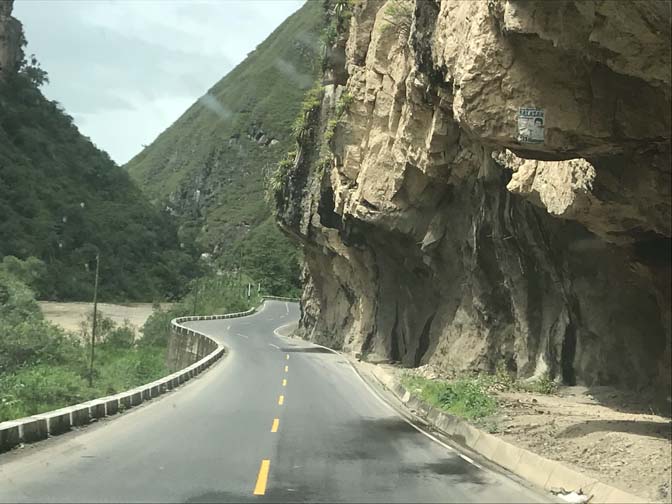
New national road, Amazonas, Peru
Now it’s about forty-five minutes to get to Tingo by car. And then, in the old days, you would have to take mules up the mountain, which would take you half a day to get up to the fortress. Now you do the whole trip up the mountain in twenty minutes via the cable cars.

New cable car crossing the mountain valley below
ED: Where did the idea come from to do explorations in the corporate sense rather than going in to do archaeological work?
GSJr: We are not limiting ourselves with what we can do with Gene Savoy Xplorations. Really, the first thing in January 2018 was to just feel things out. I was able to go to Chachapoyas. I was very, very impressed with what I saw. There is a lot of opportunity there, and the tourism is increasing. It has been doubling every year, for pretty much the last few years. According to government projections and other projections, that is only going to increase . For the most part, though, people are still not going into Gran Vilaya. The importance of Kuelap is that it was the fortress of the cities that lie beyond.
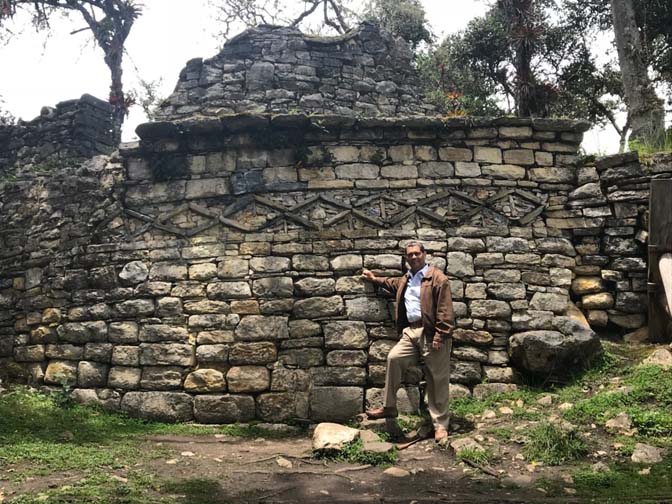
Gene Savoy Jr. at Kuelap examining Chachapoyan frieze
Kuelap basically protected what we now know as Gran Vilaya and Gran Sapasoa, which my father discovered. These were all Chachapoyan civilizations. They were conquered by the Incas. Nobody is really going beyond Kuelap. But now it is very easy to get to, for instance, Gran Vilaya. But the tourist agencies are not taking people in there yet. We believe that we can start taking people into Gran Vilaya. And that is the basis for us to establish our own tourist agency in Chachapoyas.
ED: And who is helping to put this all together?
GSJr: Right now , the main person that I work with in Peru is Ismael Seoane.
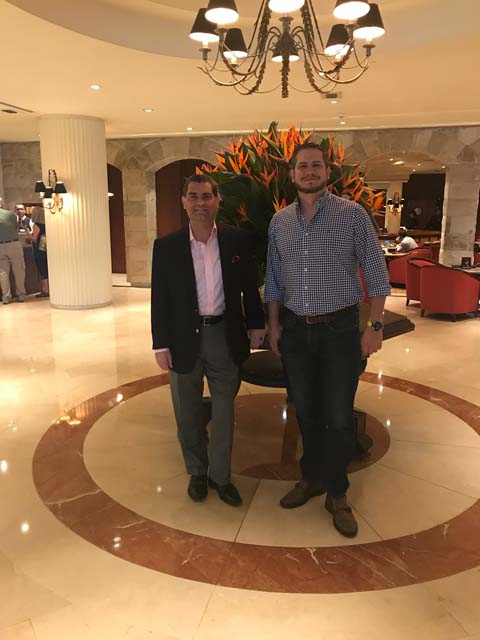
Gene Savoy Jr. and Ismael Seoane in the Swiss Hotel Lobby, Lima, Peru
He’s the third son of Pancho Seaone. [Francisco “Pancho” Seoane was the logistics officer for the Andean Explorers Foundation and worked with Gene Savoy, Sr. on his expeditions from 1984 until Pancho’s death in 1997.] Ismael is also the brother of Francisco and Alfonso Seoane. Ismael has connections. He’s the one who has connections with attorneys. These attorneys have connections with high profile people in the government, with the media and public relations firms and things like that. We are starting out with something very small. Also, his eldest brother, Francisco, is also helping in various ways. Francisco is now our archaeologist. He teaches at the University of Trujillo. He had been on a few of the expeditions when we were first there with my father. Francisco has agreed to be our official map maker and the liaison between us and the Institute of Culture. If we do anything in the future, we have to go through the Institute of Culture. So it’s very important for us to have an archaeologist that is our “archaeologist in-residence,” so to speak.
ED: Is there anyone else you have been working with in Peru?
GSJr: The other person who is helping a great deal is Martin Chumbe.
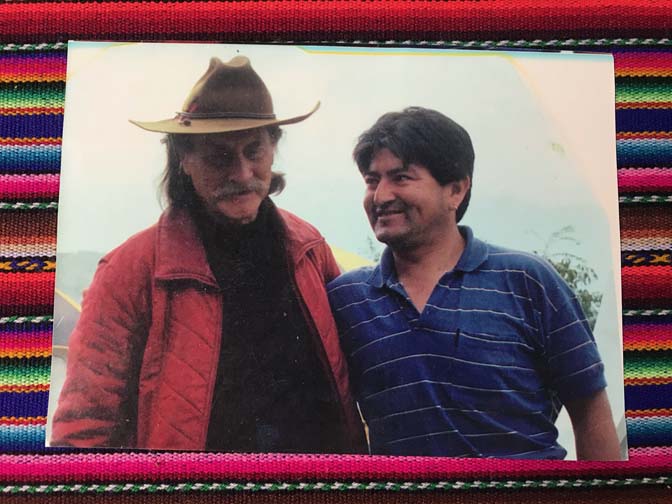
Gene Savoy Sr. and Martin Chumbe at Gran Vilaya, c. 1989
He was on expeditions when we were there in 1989 and the early 1990s. He is familiar with Gran Vilaya. He has also become very familiar with Gran Saposoa. He has connections in Chachapoyas. He is really the key to our connections in Chachapoyas. Ismael and Francisco have connections in Lima and Trujillo, but Martin is equally important because he knows everybody in Chachapoyas.
ED: And he now makes his living as a guide?
GSJr: Martin always had made his living as a guide, and he has become very prominent as a guide. Everybody knows him. Tourists seek him out to be their guide.

Gene Savoy Jr. with Martin Chumbe in expedition gear at the entrance to Gocta Falls, Amazonas, Peru
He’s very good, and he wants to work with us. He reveres my father and has pictures of him, and his relatives have copies of magazines going all the way back. They are very excited that this is now happening.
ED: You put all of this together last January?
GSJr: The initial trip was in January 2018. Other things were taking place between January and November, when I went again. By that time, we actually had a few more things in place. We were able to meet with the law firm of GLB Abogados.

Gary Buchanan, Ismael Seoane Peyon, and Gene Savoy Jr in Lima, Peru , March 7, 2020
The law firm is two brothers, and they are helping us right now putting together the legal structure for what we are going to do in Peru. At this point, the idea is to have two corporations, one for-profit and one non-profit. The reality is that people will help us get things started, but they eventually will want to be compensated for their efforts; and quite honestly, I think, so do we. If we were to start the tourist agency, which we would like to do, the plan for 2019 is to do three things: First of all, and as we speak, Martin is in the field for 75 days. What he is doing is mapping, further mapping. We have maps that Gary Buchanan did back in the old days. Martin has his own set of maps, which he has shared with us. What he is doing now is going to these sites, and, with a GPS, taking the elevations and the distances from one point to another along the trails. The idea is to approach the Peruvian government to designate a specific official route, which will be called the “Route of Savoy” or “The Savoy Route” or, in Spanish, “La Ruta de Savoy,” similar to the Inca Trail in concept. The Inca Trail is down in Cusco and Machu Picchu. If you want to backpack you can take a few days going on the Inca Trail, and you can walk to Machu Picchu. This would be the same kind of concept. La Ruta de Savoy is going to be based on all or most of the sites that my father discovered in the 1960’s. So basically, everything that was talked about in his book Antisuyo is going to be part of “La Ruta de Savoy.”
ED: Including Gran Vilaya?
GSJr: Gran Vilaya and Gran Sapasoa are going to be two other separate things. So we have some big ideas. For right now, Martin is in the field for 75 days, mapping, getting coordinates, distances, elevations. The idea is that ,with the travel agency, we’ll be able to take backpackers and campers and people like that. He needs to know, for instance, how long it takes to get from Point A to Point B, and from Point B to Point C, and so on. It takes so many days to do the whole route, but you need to set up designated places for people to camp, and this is where we need the government’s assistance to help us with investments. The government has set up some very interesting investment programs so that they can start developing these sites and then recoup their expenses with, obviously, the tourist dollars. That’s the first thing that is happening. Second, we will have an expedition. It will be kind of a scouting expedition in the summer, probably in July or August [of 2019], where we will go into Gran Saposoa with Francisco and start mapping Gran Sapasoa. It’s the place that hasn’t really been mapped. Gran Vilaya has been mapped many times. Martin will also verify certain distances and things so we can update our main map.
ED: So you are actually talking about doing three different routes?
GSJr: Yes, we are talking about three things: The Savoy Route, Gran Vilaya, and Gran Sapasoa. That’s what we’re concentrating on.
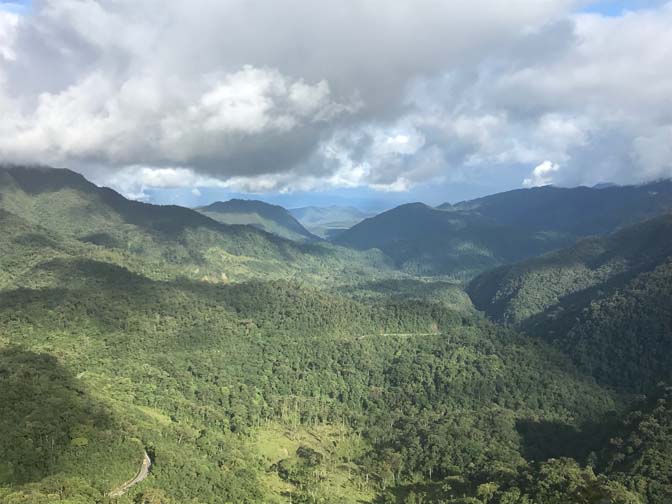
Scenic overlook, Amazonas, Peru
After the scouting expedition this year, when we have better information about places and distances and where to visit, then the idea is in 2020 to have a true expedition where we actually have some media exposure, and we will announce Gene Savoy Xplorations as being active in Peru. We’ll have the travel agency set up. And we already have people who have donated space right off the main square for the offices and all of that. So I think this is actually quite exciting. The way that I look at it is, if The Community is going to expand its ministry and at some point and some day have a presence in Peru, which I believe it should, it again has to have some basis for financial survival. So we have to set up some things that are going to bring in revenue. And, obviously, the work that we have done at the ruins can be the revenue stream that initially supports The Community’s establishment there. You have to do the one thing before the other. Otherwise, it doesn’t make any sense, in my mind.
ED: And as far as the expedition in 2020, do you want to say anything more?
GSJr: Not this point. The only people who know about it at this time are Ismael, Francisco, Martin, and I, and also Alfonso [Alfonso Seoane, also the brother of Ismael] who is helping us in Reno. The idea is that all of this will be kept quiet until we actually do something, because we want to make a big splash. But working with Ismael is easy for me because he is a businessman, so he understands that you have to take things slowly, and you have to plan things and do things properly, and make sure that everything at the back end is set up before you do anything on the front end. We don’t want to rush into things, and then have everything fall apart or be unorganized and sloppy. Then people get upset.
ED: Anything else you would like to add?
GSJr: That’s basically the whole idea, and I think that is all we really need to say right now, except that this isn’t a new idea for me. I had been talking about these ideas years ago, but certain people involved in the Andean Explorers Foundation didn’t see things my way and went off on their own doing their own thing which didn’t have anything to do with the mission of the Church. Gene Savoy Xplorations is already a legal entity here in Nevada. The attorneys have already reserved the name “Gene Savoy” in Peru on our behalf, so the whole idea is that once this comes out, who knows what’s going to happen? That’s why we are doing everything very meticulously on the back end before we make our next move. The Community has its roots in Peru and Mexico. Those places are significant to us. We shouldn’t forget that.
* * *
During the three years since the February 2019 interview with Bishop Gene, much has transpired in the world. Covid-19 was a major factor everywhere, including Peru, and The Community’s plans had to be put on hold. The planned 2020 expedition never happened. However, Gene was able to make one final trip with Gary Buchanan in February/March 2020 before Peru was locked down due to Covid and before Gary’s passing in October of that year.
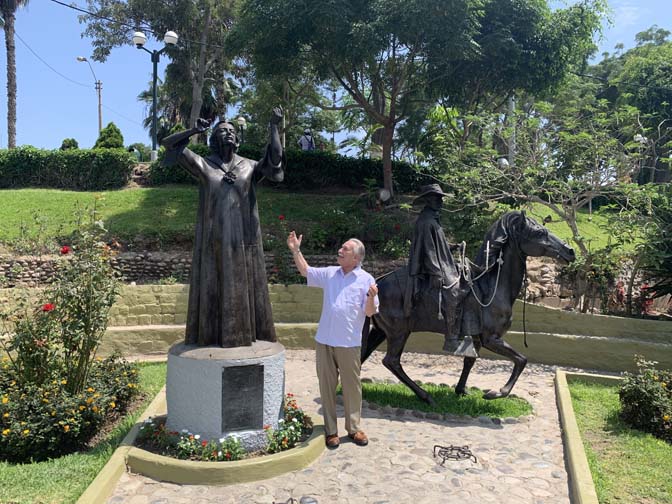
Gary Buchanan with statue of Chabuca Granda, Barranco, Lima, March 7, 2020. PHOTO: Gene Savoy Jr.
Since that time, Gene Savoy Xplorations (GSX) has developed and trademarked an official logo.

Newly trademarked logo for Gene Savoy Xplorations
The logo emphasizes the importance of the feathered, or plumed, serpent and its representation of Quetzalcoatl in Mexico, Kukulkan in Mesoamerica, and Viracocha in Peru. Readers will remember that Gene Savoy, Sr. named the three vessels he sailed Feathered Serpent I, Feathered Serpent II, and Feathered Serpent III. The first craft, which was the totora reed raft he sailed in 1969 from Peru to Panama, was also referred to as the Kuviqu, for Kukulkan, Viracocha, Quetzalcoatl.
Another positive development has been the collaboration of Gene, Jr. with Mr. Gabriel Urza. Mr. Urza, originally from Reno, Nevada, is a Fulbright Scholar and currently on the faculty of Portland State University in Portland, Oregon. (For a profile of Gabriel Urza click here.)
Mr. Urza contacted Gene in early 2021 about the possibility of writing a full biography of Gene Savoy, Sr. from his childhood and youth, to his service in the United States Navy during World War II and thereafter entering Catholic seminary to become a priest, to his explorations and life in Peru, including with The Child Jamil, the System of Cosolargy, the founding of The Community and its relocation to Reno, as well as its activities from 1957 to the present. Gene has been working with Gabriel on the project over the past year-and-a-half.
An exciting development of their working together is the opportunity for Gene to travel next month, June 2022, to the legendary site of Vilcabamba, which Gene’s father discovered in 1964. The discovery catapulted Gene Sr. on to the world stage. Gabriel invited Gene to accompany him to the famed ruins of the Inca resistance to the Spanish conquest, which Gene gladly accepted. The son of the guide who accompanied the elder Savoy in 1964 will guide the younger Savoy and Gabriel Urza on their trek next month. It is anticipated to be an exciting meeting spanning two generations of explorers!
